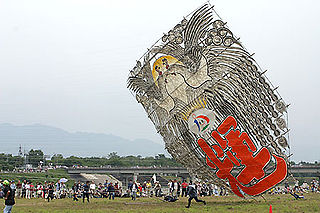
A kite is a tethered heavier-than-air or lighter-than-air craft with wing surfaces that react against the air to create lift and drag forces. A kite consists of wings, tethers and anchors. Kites often have a bridle and tail to guide the face of the kite so the wind can lift it. Some kite designs do not need a bridle; box kites can have a single attachment point. A kite may have fixed or moving anchors that can balance the kite. The name is derived from the kite, the hovering bird of prey.

The guitar is a stringed musical instrument, that is usually fretted and typically has six or twelve strings. It is usually held flat against the player's body and played by strumming or plucking the strings with the dominant hand, while simultaneously pressing selected strings against frets with the fingers of the opposite hand. A guitar pick may also be used to strike the strings. The sound of the guitar is projected either acoustically, by means of a resonant hollow chamber on the guitar, or amplified by an electronic pickup and an amplifier.

A fixed-wing aircraft is a heavier-than-air flying machine, such as an airplane, which is capable of flight using aerodynamic lift. Fixed-wing aircraft are distinct from rotary-wing aircraft, and ornithopters. The wings of a fixed-wing aircraft are not necessarily rigid; kites, hang gliders, variable-sweep wing aircraft and airplanes that use wing morphing are all classified as fixed-wing aircraft.
Hornbostel–Sachs or Sachs–Hornbostel is a system of musical instrument classification devised by Erich Moritz von Hornbostel and Curt Sachs, and first published in the Zeitschrift für Ethnologie in 1914. An English translation was published in the Galpin Society Journal in 1961. It is the most widely used system for classifying musical instruments by ethnomusicologists and organologists. The system was updated in 2011 as part of the work of the Musical Instrument Museums Online (MIMO) Project.

A sport kite, also commonly known as a stunt kite, is a type of kite that can be maneuvered in the air. A related kite, also controllable and used for recreation, but capable of generating a significant amount of pull and used for providing movement, is the power kite.

The geomungo or hyeongeum is a traditional Korean plucked zither with both bridges and frets. Geomungo is a representative stringed instrument made in Goguryeo before the 5th century. Scholars believe that the name refers to Goguryeo and translates to "Goguryeo zither" or that it refers to the colour and translates to "black crane zither".

The Progressive Labour Party (PLP) is one of the two political parties in Bermuda. At the 18 July 2017 general election, the party won 24 of the 36 seats in the Bermudian House of Assembly to become the governing party. The party was founded in 1963, the first political party in Bermuda, and the oldest still active. It formed government from 1998 to 2012, and again since 2017.

A violin consists of a body or corpus, a neck, a finger board, a bridge, a soundpost, four strings, and various fittings. The fittings are the tuning pegs, tailpiece and tailgut, endpin, possibly one or more fine tuners on the tailpiece, and in the modern style of playing, usually a chinrest, either attached with the cup directly over the tailpiece or to the left of it. There are many variations of chinrests: center-mount types such as Flesch or Guarneri, clamped to the body on both sides of the tailpiece, and side-mount types clamped to the lower bout to the left of the tailpiece.
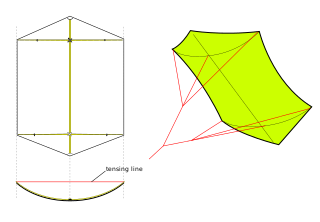
The Rokkaku dako (六角凧) is a traditional six-sided Japanese fighter kite. Traditionally, it is made with bamboo spars and washi paper. The rokkaku kite is often hand painted with the face of a famous Samurai. The structure is a vertically stretched hexagon with a four-point bridle. One bamboo runs from tip to toe, and there are two cross-spars. Flown on a taut string, the kite is stable and rises rapidly. When the line is released, the kite tumbles until tension is put on the line, at which point it takes off in the direction of the spine. Fighting two or more of these kites involves tipping over or destabilizing the opposing kite or cutting its kite line or bridle. Cows are often painted on kites to resemble wealth.
A lacrosse stick or crosse is used to play the sport of lacrosse. Players use the lacrosse stick to handle the ball and to strike or "check" opposing players' sticks, causing them to drop the ball. The head of a lacrosse stick is roughly triangular in shape and is strung with loose netting that allows the ball to be caught, carried, passed, or shot.
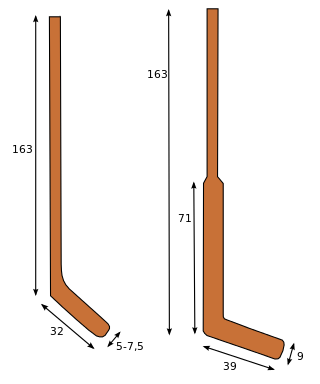
An ice hockey stick is a piece of equipment used in ice hockey to shoot, pass, and carry the puck across the ice. Ice hockey sticks are approximately 150–200 cm long, composed of a long, slender shaft with a flat extension at one end called the blade. National Hockey League (NHL) sticks are up to 63 inches long. The blade is the part of the stick used to contact the puck, and is typically 25 to 40 cm long. Stick dimensions can vary widely, as they are usually built to suit a particular player's size and preference. The blade is positioned at roughly a 135° angle from the axis of the shaft, giving the stick a partly 'L-shaped' appearance. The shaft of the stick is fairly rigid, but is slightly elastic to improve shot performance.

In field hockey, each player carries a stick and cannot take part in the game without it. The stick for an adult is usually in the range 89–95 cm (35–38 in) long. A maximum length of 105 cm (41.3") was stipulated from 2015. The maximum permitted weight is 737 grams. The majority of players use a stick in the range 19 oz to 22 oz. Traditionally hockey sticks were made of hickory, ash or mulberry wood with the head of the sticks being hand carved and therefore required skilled craftsmen to produce. Sticks made of wood continue to be made but the higher grade sticks are now manufactured from composite materials which were first permitted after 1992. These sticks usually contain a combination of fibreglass, aramid fiber and carbon fibre in varying proportions according to the characteristics required.

Fighter kites are kites used for the sport of kite fighting. Traditionally, most are small, unstable single-line flat kites where line tension alone is used for control, at least part of which is manja, typically glass-coated cotton strands, to cut down the line of others.

Kites are tethered flying objects which fly by using aerodynamic lift, requiring wind for generation of airflow over the lifting surfaces.
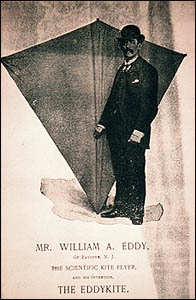
The Malay kite is a model of tailless kite. First introduced to the West in a New York City newspaper article from October 1894, the Malay kite was used for recreation for centuries before this in parts of the Far East. The article detailed how a university professor ("Clayton") had erected a series of kites and bound them all together to one kite. These kites had no tail, were bowed and diamond-shaped, and were referred to by the article writer as "Malay kites". However, the existence of a Malay-like design may have already been heard of in the United States sometime before the publishing of the article; in the last edition of the American Boy's Handy Book, another tailless kite is described. The description of this kite, which was to be included as a chapter in the book, was sent in to the author sometime around 1882, eleven years before the Malay kite was mentioned in the newspaper.
Edgar Fitzgerald Gordon, born in Trinidad and Tobago, was a physician, parliamentarian, civil-rights activist and labour leader in Bermuda, and is regarded as the "father of trade unionism" there: "he championed the cause of Bermudian workers and fought for equal rights for black Bermudians, thereby laying the groundwork for much of the political and social change that came about after his death". He was president of the Bermuda Industrial Union (BIU) 1945–55. Gordon has been described as "perhaps the only black charismatic leader to have emerged in the island's modern political history", and as "Bermuda's most dedicated Pan-Africanist".

Traditional games of Korea have been influenced by the culture, history and environment of Korea. Examples of popular traditional games include jegichagi, neolttwigi, ssireum, tuho, and yut.
Same-sex marriage is currently not recognised nor performed in Bermuda, a British Overseas Territory, but it was legal between 2017 and 2022. However, marriages performed during that period remain valid.
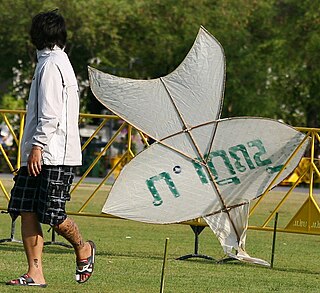
Kites have been popular in Thai society for a long time. Since the Sukhothai period, King Ramkamhaeng fully supported kite flying, so kites became a main part of Thai culture. There was also evidence that King Rama V (1868-1910) of the Rattanakosin kingdom enjoyed kite flying very much so the formal competition of kite flying was firstly created in his reign. The famous venue for kite flying in Thailand is Sanam Luang, royal turf, which has been used since 1855 in Bangkok.

The tube zither is a stringed musical instrument in which a tube functions both as an instrument's neck and its soundbox. As the neck, it holds strings taut and allows them to vibrate. As a soundbox, it modifies the sound and transfers it to the open air. The instruments are among the oldest of chordophones, being "a very early stage" in the development of chordophones, and predate some of the oldest chordophones, such as the Chinese Se, zithers built on a tube split in half. Most tube zithers are made of bamboo, played today in Madagascar, India, Southeast Asia and Taiwan. Tube zithers made from other materials have been found in Europe and the United States, made from materials such as cornstalks and cactus.



















